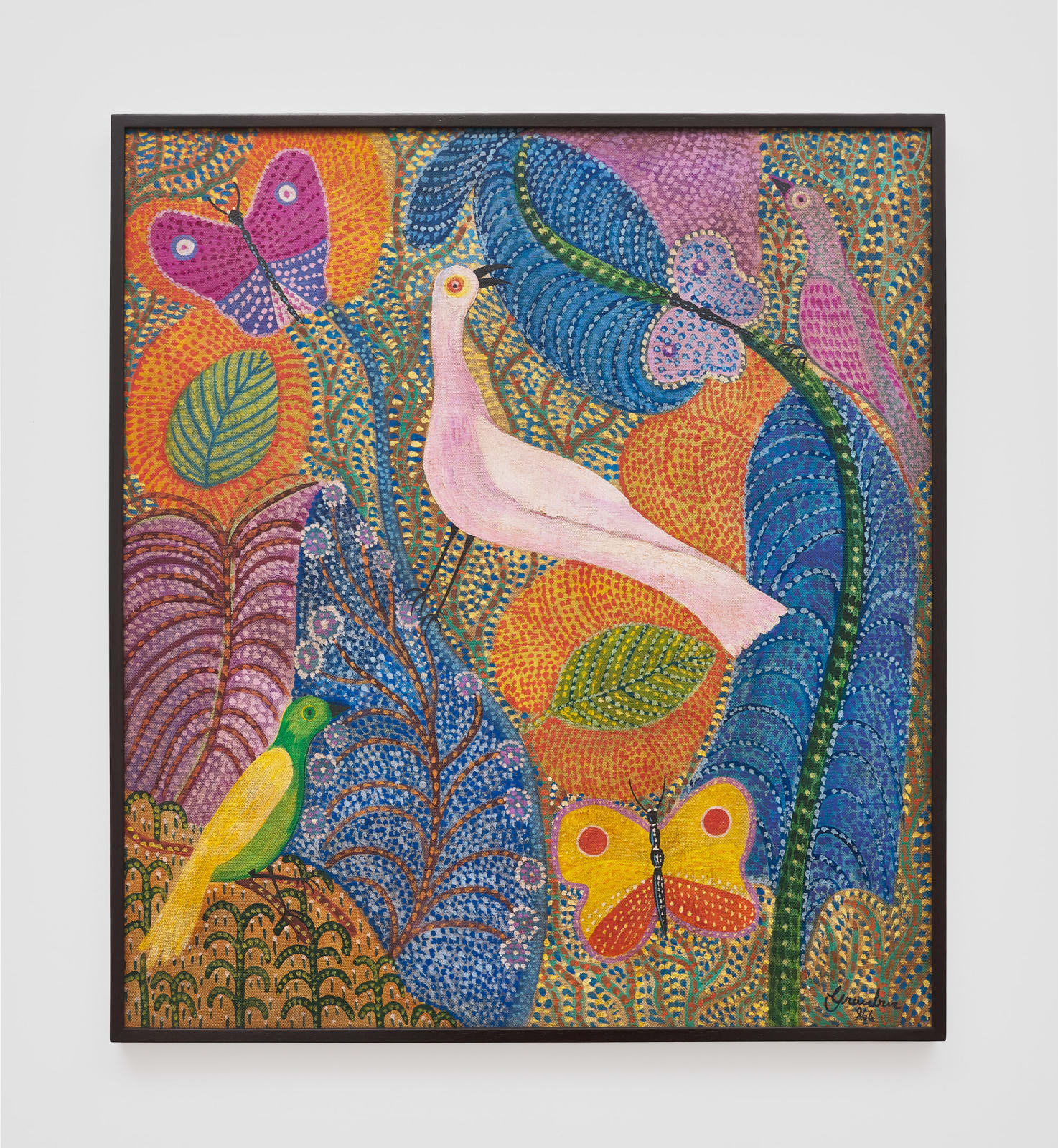Grauben: the point of twilight : ArtRio 2023
- Grauben do Monte Lima, Pavão azul, década de 1960 [1960s]
- Grauben do Monte Lima, Sem título [Untitled], 1965
- Grauben do Monte Lima, Pássaros, borboletas e flores, 1967
- Grauben do Monte Lima, Pássaros, borboletas e vegetações, 1965
- Grauben do Monte Lima, Floresta, 1969
- Grauben do Monte Lima, Sem título [Untitled], 1967
- Grauben do Monte Lima, Sem título [Untitled], 1967
- Grauben do Monte Lima, Sem título [Untitled], 1965
- Grauben do Monte Lima, Sem título [Untitled], 1968
- Grauben do Monte Lima, Sem título [Untitled], 1968
- Grauben do Monte Lima, Sem título [Untitled], 1966
- Grauben do Monte Lima, Sem título [Untitled], 1969
- Grauben do Monte Lima, Sem título [Untitled], 1964
- Grauben do Monte Lima, Sem título [Untitled], 1966
- Grauben do Monte Lima, Paisagem com borboletas e pássaros, 1964
- Grauben do Monte Lima, Sem título [Untitled], 1969
- Grauben do Monte Lima, Sem título [Untitled], 1970
- Grauben do Monte Lima, Sem título [Untitled], 1966
- Grauben do Monte Lima, Pássaros na Paisagem, 1966
- Grauben do Monte Lima, Pássaros e borboletas, 1964
- Grauben do Monte Lima, Sem título [Untitled], 1966
- Foto [Photo]: Rafael Salim
- Foto [Photo]: Rafael Salim
- Foto [Photo]: Rafael Salim
- Foto [Photo]: Rafael Salim
- Foto [Photo]: Rafael Salim
Grauben: the point of twilight
Galatea's project for ArtRio 2023, Grauben: the point of twilight, presents a selection of 21 works by Grauben do Monte Lima (Iguatu, CE, 1889 - Rio de Janeiro, RJ, 1972). As part of our proposal to reposition historical artists on the contemporary scene, with this project we aim to bring back into focus and debate the production of this artist with such a suis generis and remarkable trajectory in 20th century Brazilian painting.
Grauben began painting in 1960, at the age of 70, in a self-taught way, when her niece gave her a box of watercolors. When some of her work came into the hands of Ivan Serpa, she was encouraged by the artist and teacher to continue and follow his classes at the Museum of Modern Art in Rio de Janeiro. From then on, she never stopped. She quickly gained a place in important Brazilian and international galleries and institutions, taking part in the 7th São Paulo Biennial in 1963, the exhibition ‘8 peintres naïfs brésiliens’ at the Jacques Massol gallery in Paris in 1965 and a solo show in 1966, which brought together 80 of her paintings, at the MAM Rio — among other great achievements.
In a career that lasted just over ten years, in the last decade of her life, she produced almost three thousand paintings in which she developed what the critic Walmir Ayala called "neo-impressionism, with imaginary landscapes composed in small brushstrokes, like points of light".
![Grauben do Monte Lima, Pavão azul, década de 1960 [1960s]](https://artlogic-res.cloudinary.com/w_1600,h_1600,c_limit,f_auto,fl_lossy,q_auto/artlogicstorage/antoniabergamin/images/view/ca1b60e041ff333502b7be37bcc2b230j/galatea-grauben-do-monte-lima-pav-o-azul-d-cada-de-1960-1960s.jpg)
![Grauben do Monte Lima, Sem título [Untitled], 1965](https://artlogic-res.cloudinary.com/w_1600,h_1600,c_limit,f_auto,fl_lossy,q_auto/artlogicstorage/antoniabergamin/images/view/d5520bafa85687ea1a734d4bc929ddffj/galatea-grauben-do-monte-lima-sem-t-tulo-untitled-1965.jpg)



![Grauben do Monte Lima, Sem título [Untitled], 1967](https://artlogic-res.cloudinary.com/w_1600,h_1600,c_limit,f_auto,fl_lossy,q_auto/artlogicstorage/antoniabergamin/images/view/37d65cdead16d7403d7d966a8e8ee969j/galatea-grauben-do-monte-lima-sem-t-tulo-untitled-1967.jpg)
![Grauben do Monte Lima, Sem título [Untitled], 1967](https://artlogic-res.cloudinary.com/w_1600,h_1600,c_limit,f_auto,fl_lossy,q_auto/artlogicstorage/antoniabergamin/images/view/a6ca20567533cd4f457afafc1a9a0fb6j/galatea-grauben-do-monte-lima-sem-t-tulo-untitled-1967.jpg)
![Grauben do Monte Lima, Sem título [Untitled], 1965](https://artlogic-res.cloudinary.com/w_1600,h_1600,c_limit,f_auto,fl_lossy,q_auto/artlogicstorage/antoniabergamin/images/view/3f1edca641d6684dae301305a77ab393j/galatea-grauben-do-monte-lima-sem-t-tulo-untitled-1965.jpg)
![Grauben do Monte Lima, Sem título [Untitled], 1968](https://artlogic-res.cloudinary.com/w_1600,h_1600,c_limit,f_auto,fl_lossy,q_auto/artlogicstorage/antoniabergamin/images/view/2ec2254232719e7daebf4b9f33d83071j/galatea-grauben-do-monte-lima-sem-t-tulo-untitled-1968.jpg)
![Grauben do Monte Lima, Sem título [Untitled], 1968](https://artlogic-res.cloudinary.com/w_1600,h_1600,c_limit,f_auto,fl_lossy,q_auto/artlogicstorage/antoniabergamin/images/view/59f25b217dfae937575b0c2506d7d6b0j/galatea-grauben-do-monte-lima-sem-t-tulo-untitled-1968.jpg)
![Grauben do Monte Lima, Sem título [Untitled], 1966](https://artlogic-res.cloudinary.com/w_1600,h_1600,c_limit,f_auto,fl_lossy,q_auto/artlogicstorage/antoniabergamin/images/view/245d3931646e75df0c985ee63db814a4j/galatea-grauben-do-monte-lima-sem-t-tulo-untitled-1966.jpg)
![Grauben do Monte Lima, Sem título [Untitled], 1969](https://artlogic-res.cloudinary.com/w_1600,h_1600,c_limit,f_auto,fl_lossy,q_auto/artlogicstorage/antoniabergamin/images/view/cabdb98b3a0a47f144b2353a29b26edaj/galatea-grauben-do-monte-lima-sem-t-tulo-untitled-1969.jpg)
![Grauben do Monte Lima, Sem título [Untitled], 1964](https://artlogic-res.cloudinary.com/w_1600,h_1600,c_limit,f_auto,fl_lossy,q_auto/artlogicstorage/antoniabergamin/images/view/f65ebab5e47643e56f5e6e5d0fab4bdcj/galatea-grauben-do-monte-lima-sem-t-tulo-untitled-1964.jpg)
![Grauben do Monte Lima, Sem título [Untitled], 1966](https://artlogic-res.cloudinary.com/w_1600,h_1600,c_limit,f_auto,fl_lossy,q_auto/artlogicstorage/antoniabergamin/images/view/4763ad496cf55c5eb0bb91c13582de27j/galatea-grauben-do-monte-lima-sem-t-tulo-untitled-1966.jpg)

![Grauben do Monte Lima, Sem título [Untitled], 1969](https://artlogic-res.cloudinary.com/w_1600,h_1600,c_limit,f_auto,fl_lossy,q_auto/artlogicstorage/antoniabergamin/images/view/cd2db09a87c80f116771456d498981c1j/galatea-grauben-do-monte-lima-sem-t-tulo-untitled-1969.jpg)
![Grauben do Monte Lima, Sem título [Untitled], 1970](https://artlogic-res.cloudinary.com/w_1600,h_1600,c_limit,f_auto,fl_lossy,q_auto/artlogicstorage/antoniabergamin/images/view/034955694d2786333a0749f843445bb7j/galatea-grauben-do-monte-lima-sem-t-tulo-untitled-1970.jpg)
![Grauben do Monte Lima, Sem título [Untitled], 1966](https://artlogic-res.cloudinary.com/w_1600,h_1600,c_limit,f_auto,fl_lossy,q_auto/artlogicstorage/antoniabergamin/images/view/aa55e2aae86ee3d06be14e7b92579ec5j/galatea-grauben-do-monte-lima-sem-t-tulo-untitled-1966.jpg)


![Grauben do Monte Lima, Sem título [Untitled], 1966](https://artlogic-res.cloudinary.com/w_1600,h_1600,c_limit,f_auto,fl_lossy,q_auto/artlogicstorage/antoniabergamin/images/view/b790b566eed256a5d0ebfeb2b6d0346dj/galatea-grauben-do-monte-lima-sem-t-tulo-untitled-1966.jpg)
![Foto [Photo]: Rafael Salim](https://artlogic-res.cloudinary.com/w_1600,h_1600,c_limit,f_auto,fl_lossy,q_auto/ws-artlogicwebsite1200/usr/library/images/main/events/9/galatea-_-artrio-2023-_-4.jpg)
![Foto [Photo]: Rafael Salim](https://artlogic-res.cloudinary.com/w_1600,h_1600,c_limit,f_auto,fl_lossy,q_auto/ws-artlogicwebsite1200/usr/library/images/main/events/9/galatea-_-artrio-2023-_-5.jpg)
![Foto [Photo]: Rafael Salim](https://artlogic-res.cloudinary.com/w_1600,h_1600,c_limit,f_auto,fl_lossy,q_auto/ws-artlogicwebsite1200/usr/library/images/main/events/9/galatea-_-artrio-2023-_-3.jpg)
![Foto [Photo]: Rafael Salim](https://artlogic-res.cloudinary.com/w_1600,h_1600,c_limit,f_auto,fl_lossy,q_auto/ws-artlogicwebsite1200/usr/library/images/main/events/9/galatea-_-artrio-2023-_-1.jpg)
![Foto [Photo]: Rafael Salim](https://artlogic-res.cloudinary.com/w_1600,h_1600,c_limit,f_auto,fl_lossy,q_auto/ws-artlogicwebsite1200/usr/library/images/main/events/9/galatea-_-artrio-2023-_-6.jpg)

